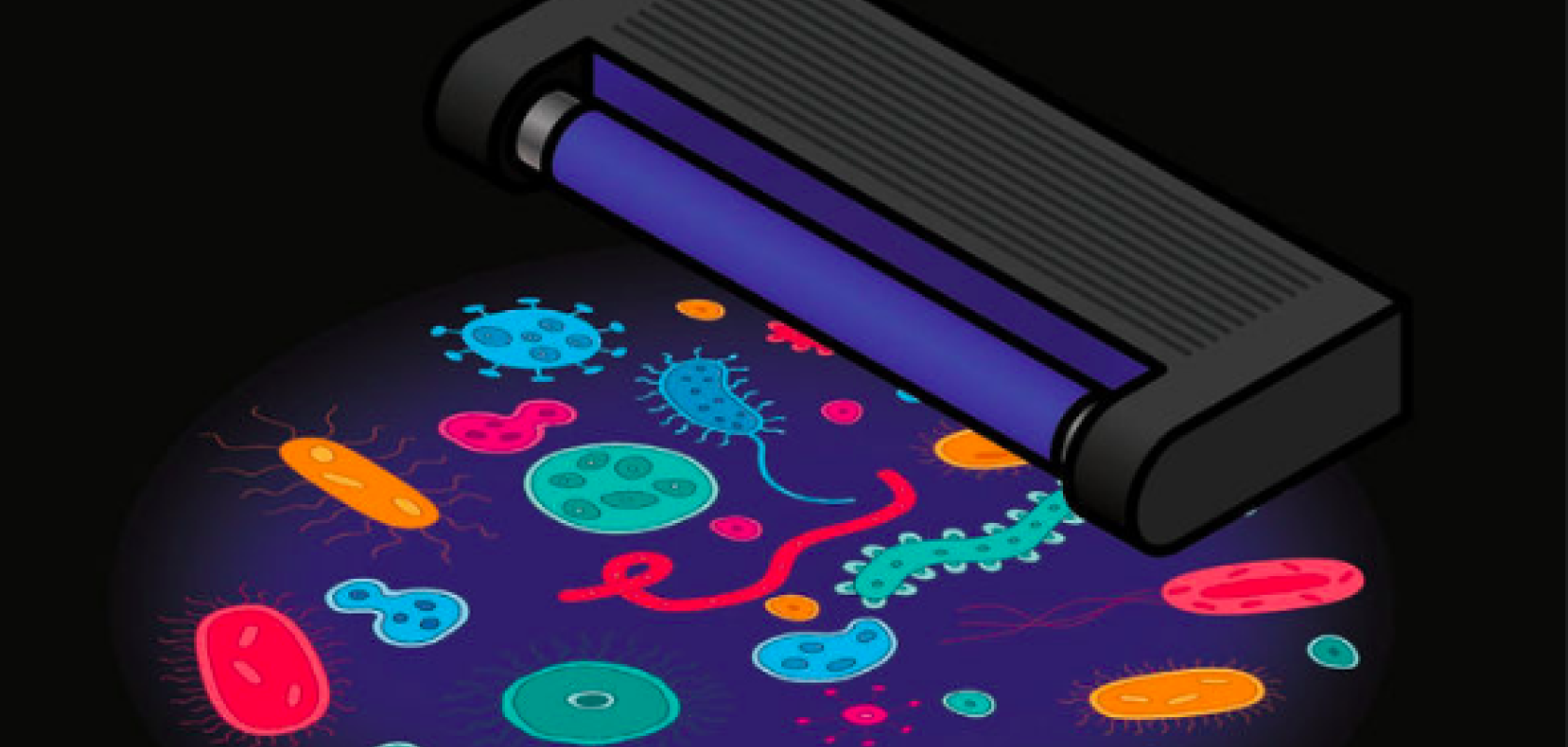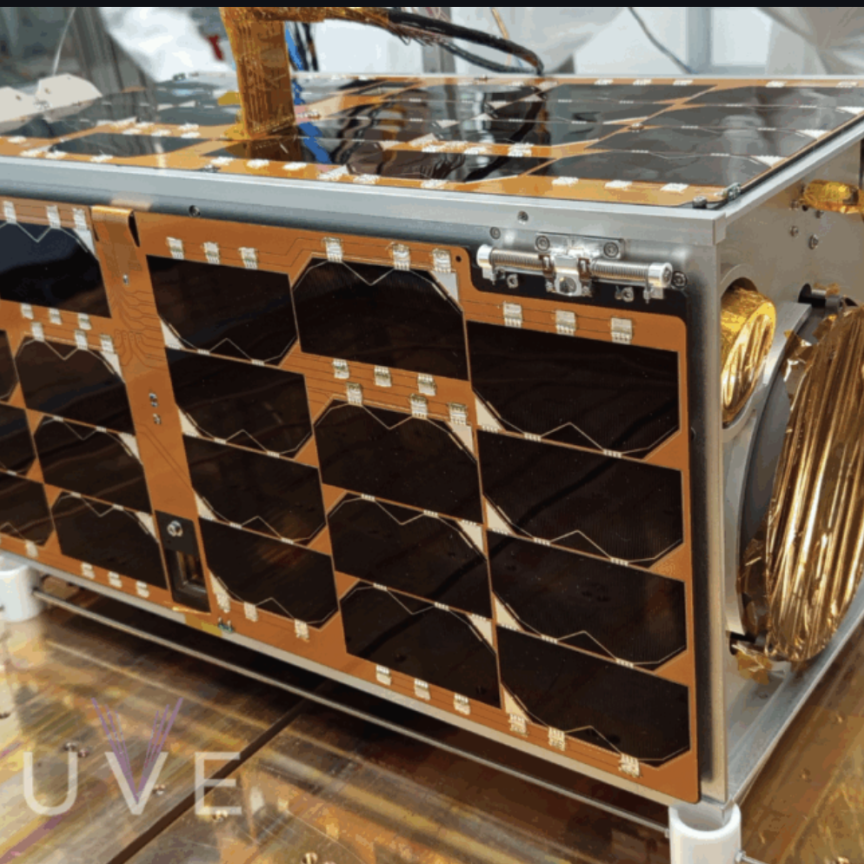Robert Yeo first became concerned about attempts to use ultraviolet (UV) light to fight coronavirus on 5 June last year. That day he took his car to be serviced – the first day the UK’s anti-coronavirus lockdown restrictions were lifted sufficiently to allow it. ‘The garage proudly took my car keys off me, put them inside this UV light box and said, “There you go, you’re safe now,”’ Yeo recalled. They also told Yeo, director at Pro-Lite Technology, that engineers would disinfect his steering wheel, presumably with a UV light wand, a stick with many UV LEDs embedded in it. As a professional in the optics industry, Yeo therefore asked to see the device’s specifications. ‘They showed me, and nowhere did it talk about irradiance and dose,’ Yeo explained. UV wands in particular, which users can wave briefly over a surface without delivering a sufficient light dose, Yeo strongly suspects, are ‘no better than toys’.
This situation reflects that, even as vaccines are successfully deployed in some countries, the world remains desperate for better solutions to the pandemic. Yeo highlighted that UV light – specifically the UV-C part spectrum, that extends from 100 to 280nm – has great potential to fight the coronavirus. Previously 254nm light – a traditional UV disinfection wavelength originating from mercury discharge lamps – had been shown to inactivate the Sars virus by damaging its genetic material1. But it can also damage human cells, Yeo stressed, with longer UV-C potentially causing damage to skin and eyes. As such, users need to be sure that all products work and are safe. Spectroradiometry offers a way for vendors and users alike to have more confidence in their technology – or show, in some cases, that Yeo’s worries are justified.
UV disinfection is a well-established technology, explained Jill Fowler, director of sales at International Light Technologies (ILT), based in Massachusetts, who added that the most effective wavelengths for killing pathogens are from 250 to 280nm. ‘Recent studies have shown promise that both 222 and 405nm are safer to use,’ she said, including against Covid-192.
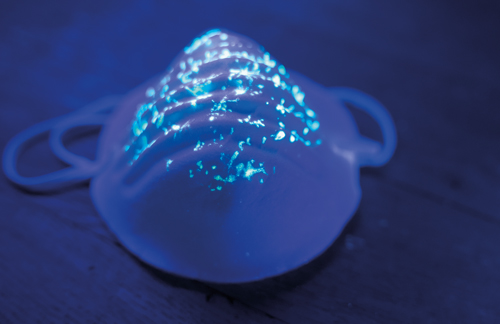
Credit: Ocean Insight
Low pressure mercury lamps are the lowest cost source, Fowler continued. However, other sources like UV LEDs and far UV-C excimer lamps have other benefits. ‘The advantages of UV-C LEDs include that they do not emit ozone, use less power and do not contain mercury,’ Fowler said. ‘Such LEDs have a longer life, and they have a conveniently small form factor.’ However they do cost more, especially in the traditional 260-265nm range.
Meanwhile, excimer lamps rely on a krypton/chlorine gas mixture and come both with and without UV-B and UV-A blocking filters, which ‘have a great impact on their safety rating,’ said Fowler. ‘Excimer lamps can be safe for human exposure for longer periods of time, but not all are tested for safe use,’ she explained.
Improving knowledge
As such, potential system buyers should educate themselves in the science and dangers of UV-C, potentially including equipping themselves with measurement equipment, said Andrea Stefkova, commercial operations and analytics manager at Ocean Insight. ‘UV-C is dangerous and should be treated with caution,’ she said. ‘Verifying the device output and asking the manufacturer for any certification of testing that they performed is necessary.’ UV-C light’s germicidal effects has seen it used in hospitals, water purification, heating, ventilation and air conditioning (HVAC) systems, plus food applications, Stefkova explained. Because UV-C is dangerous to humans, most applications are in enclosed spaces. Stefkova therefore welcomes the study showing that less hazardous far UV-C 222nm light does not penetrate mammalian cells, but can still disinfect coronavirus.
The first International Conference on UV Disinfection for Air and Surfaces (ICUDAS) in December discussed the effectiveness and hazards of using UV-C for such purposes. Stefkova also noted that the International Ultra-Violet Association (IUVA), which ran ICUDAS, has published a fact sheet on UV disinfection for Covid-19. Such measures might address what Stefkova feels is a lack of knowledge of the technology.
‘This market experienced large growth due to Covid-19 and the regulatory measures are lagging,’ Stefkova said. ‘The regulatory landscape in air and surface disinfection isn’t well established but there are new regulations coming into play.’
Stefkova explained that standards and regulation are application specific, with compliance achieved by a combination of various standards, as there is no one all-encompassing standard. They mostly cover safety. Currently, many devices require CE certification or equivalent and Medical Device Regulation (MDR) for medical applications. A new part of IEC 62471 is also being drafted to cover photobiological safety. ‘IEC 62471-6 will list specific applications and precautions but it will still only mention the product,’ Stefkova said. ‘This part of the standard will help minimise risk of bad installation, it will group products and detail how they are to be used. Agreeing on nomenclature and classification will help impose clear measures for the industry.’
To ensure safe deployment of UV-C disinfection, spectroscopy is an essential tool, Stefkova continued. ‘Being able to measure the wavelength when deploying UV-C disinfection systems will aid the safe operation – for effective disinfection, the proper dosage needs to arrive at a surface. Dosage is a calculation of energy over area, and energy is dependent on the wavelength. Knowing the wavelength enables the dosage calculation and potential exposure.’
UV lamps have a limited lifetime, so not only is it important to control quality during manufacture but during use too, Stefkova added. ‘Hand-held spectroscopy is a tool that can be used on the production line and by the end-user,’ she said. ‘As the regulatory landscape for UV-C is in its infancy, any system should be validated and frequently checked.’
As one option, Ocean Insight’s spectrometers are accurate and portable, Stefkova said. The company is developing a UV version of its WaveGo hand-held spectrometer which can pair with a user’s phone for simple data interpretation, reading and storage, she said.
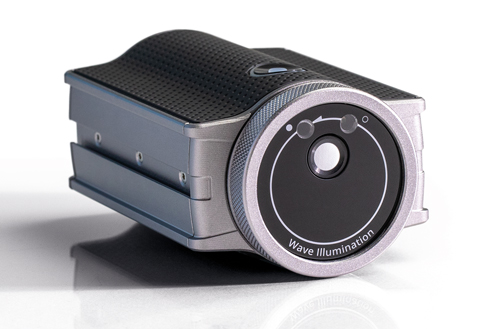
Ocean Insight is developing a UV version of its WaveGo handheld spectrometer that can pair with a user’s phone for simple data interpretation, reading and storage
Distance reduces irradiance
Pro-Lite’s Yeo suggested that spectroradiometry may not always be completely necessary to assess UV light source safety. ‘It gives more data than a simple radiometer, a light meter filtered to only receive the UV-C part of the spectrum,’ he explained. ‘A radiometer would tell you if there is UV-C radiation or not.’ But UV-C radiometers like the Solar Light range that Pro-Lite supplies predominantly measure the 254nm emission peak originating from mercury lamps. ‘The problem comes if you’re interested in 230nm,’ he said. ‘If you were a manufacturer of a UV-C disinfection device, it’s probably an easy choice between a radiometer and a spectrometer, because there’s not a lot of price difference. Spectroradiometers such as those from Avantes and Jeti, which Pro-Lite supplies, are definitely more expensive, but we’re not talking times 10.’
One reason such instruments are important is because ‘you can’t assume that an instantaneous exposure is going to have the desired effect’, Yeo continued. Lamp effectiveness depends on irradiance, power per unit area delivered to the surface. That depends on the distance between the lamp and the surface being irradiated in an inverse square relationship, Yeo stressed. As such, doubling the distance quarters the irradiance. ‘That’s not a well understood concept,’ he said.
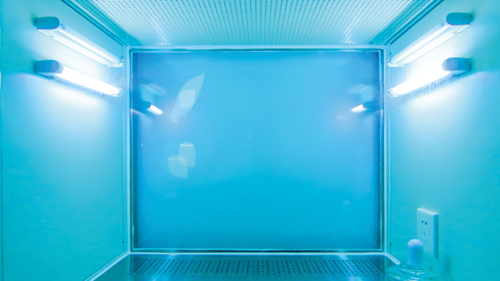
UV sterilisation of a large area in action. Credit: Ocean Insight
Producers should therefore use tools to quantify performance and provide simple guidance. ‘The manufacturer of the disinfecting product should define the distance at which you hold the lamp over the surface, and how long you should hold it there,’ Yeo said. ‘Lovely looking UV light sources that are available very inexpensively might not be at all effective.’ And that’s just what tests have shown.
At the ICUDAS meeting Gareth John, of the UK’s Lighting Industry Association (LIA), revealed results of testing hand-held UV wands. LIA usually offers a service to manufacturers and other companies wanting to test lighting’s optical specifications, John explained. Among its test equipment is an IDR300 photobiological safety spectroradiometer made by UK firm Bentham, which can cover the range from 200 to 1,100nm. LIA has been testing UV Covid disinfection products as a service to interested parties, but also a random sample of seven wands bought from the internet in its own study.
‘We’ve been looking at kill rates of 200J/m2, enough energy to kill 99 per cent of known germs,’ John told Electro Optics. ‘A lot [of devices] didn’t deliver any UV-C at all. Plenty of them were just based on 405nm LEDs, so you get a sort of indigo glow.’ Meanwhile, for some wands that do deliver UV-C, the dose was so weak that it would have taken up to 10 minutes to reach the specified kill rate. ‘These things tend to be marketed as something you can sweep across the surface for two minutes or so,’ John stressed. The wands should also have gravity-sensing switches that turn off the light when it’s turned towards a user, to protect their eyes. However, only one of the seven wands had this switch and delivered enough UV-C to kill germs quickly. LIA has now supplied these results to Public Health England.
Safety aware
While there are many poor products out there, there are also some that should do the job intended, John emphasised. ‘There are plenty of good products out there that have been created by people who do actually know what they’re doing and are getting good market penetration,’ he said. ‘If you go and talk to people who have actually studied this technology, for instance members of the IUVA, you’re generally going to get something which is much higher calibre.’
The LIA has also tested UV light boxes, which can be equally ineffective, John noted. It has also assessed trolley-mounted devices carrying 18 UV-C tubes. These achieve the desired kill rates in a very short time, John said, but also require safety devices that ensure they don’t operate when people are nearby. ‘It’s very easy to kill micro-organisms with UV – the difficult bit is not harming human beings while you’re doing it,’ he said.
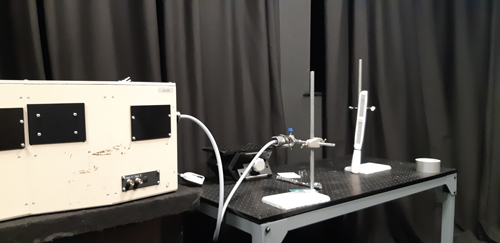
The LIA found just one out of seven UV wands bought online safely delivered UV light in a large enough dose to kill germs
To verify safety, Fowler recommended using measurement systems like the ILT960UV-RAA4, using threshold limits specified by the American Conference of Governmental Industrial Hygienists. UV spectrometers that include proper input optics and calibrations are excellent tools for verifying both the wavelength and the irradiance that is being emitted, Fowler explained. ‘For disinfection, it is best to verify where the risk is greatest and the light may have a harder time reaching and extend exposure times, so that the harder to reach areas are getting the proper dosage,’ she said. To help suppliers, ILT offers testing of UV wands and other smaller devices and cabinets, as well as sales and rental of UV meters and spectrometers, Fowler said.
She has the following advice for how potential buyers of UV disinfection equipment can ensure that systems meet their needs but don’t cause extra health problems. ‘First and foremost, you cannot see UV, so be prepared,’ she said. ‘Goggles and skin protection should be used, or leave the area during use. UV is highly reflective and will bounce around and off of surfaces. It may also leak out of the side and back of hand-held devices, causing high risk of eye and skin damage. Second, check customer reviews for the product and company. Third, and no less important, does the source produce enough dose to be effective for the item or area being disinfected? If the supplier does not list a dose, dose time and/or irradiance and cannot provide any testing value, do not buy. Last, consider buying a UV meter to assure your UV levels are fairly stable during the testing and over days, weeks and months of use.’
Fowler’s advice is ‘trust but verify’. She said: ‘If you are going to implement UV in your disinfection protocol, be sure to have a means of verifying the safety of the personnel in the area, such as the ability to leave during treatment, and that the required dose is being supplied to the furthest area from the source.’
References
1 M Darnell, K Subbarao, S Feinstone and D Taylor 2004. Inactivation of the coronavirus that induces severe acute respiratory syndrome, SARS-CoV. Journal of Virological Methods, 121(1), pp.85-91.
2 M Buonanno, D Welch, I Shuryak and D Brenner, 2020. Far-UVC light (222 nm) efficiently and safely inactivates airborne human coronaviruses. Scientific Reports, 10(1).
The measurement of LED (light emitting diode) presents unique application requirements. They can be measured in a wide variety of colours and brightnesses. Accurate measurement of the LEDs, therefore, is essential. This can be done in two ways: photometry and radiometry. Photometry relates to visible radiation alone, just as the response of the human eye.
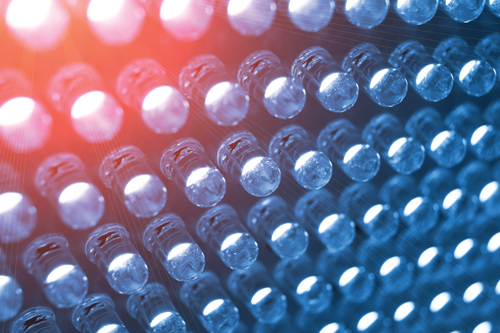
Radiometry goes beyond these limitations. In both photometry and radiometry, the LED can be characterised in emitted power or in intensity. Emitted power is all the power (flux) emitted from the LED in lumens or Watts, collected and measured without regard to the direction of the flux.
The intensity is the ratio of the flux, leaving the source and propagating in the element of solid angle containing the given direction, expressed in candelas. To guarantee the right measurement of LED, it is therefore important to make use of intensity calibrated systems. The systems used for this are often based on a spectrometer, in combination with a fibre and integrating sphere as a measurement head. It is important to have the knowledge of how to interpret the intensity information provided by the spectrometer.
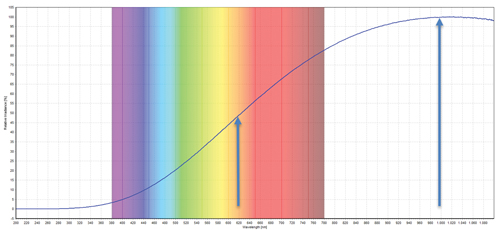
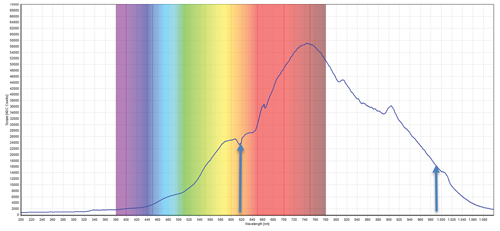
Figure 1: On the left a typical Halogen spectrum, on the right the Raw data signal from the spectrometer
Spectroscopy – Raw data versus Intensity calibrated data
The system described analyses light received by the measurement head. As light travels through the system, all optical properties of the components inside (fibre, grating, detector, mirrors and so on) affect the raw data signal coming out of a spectrometer. So when looking at the light coming from a tungsten halogen lamp, the output of a spectrometer is not the spectrum one finds in literature, but a distorted signal such as depicted in figure 1. So, comparing the intensity (height) of the signals at 620 and 1,000nm one would, based on the raw data, state that the signal is lower at 1,000nm. However, in reality the signal is about twice as high. To compensate for this, the spectrometer system needs to be calibrated for intensity. With an absolute intensity, the needed values are not only determined by converting the spectrum comparing it only to the shape of a lamp, but one also needs to determine how much power is coming from this lamp. This is done by calibrating the system against a NIST calibrated light source, as seen in figure 2.
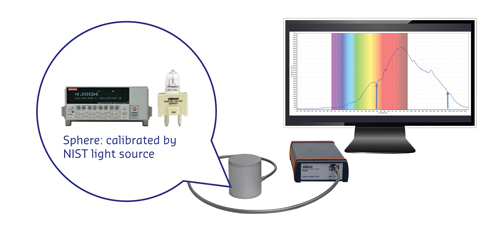
Figure 2: Calibrated system with NIST calibrated light source
The intensity calibration contains the data transfer function for each pixel. The data transfer function is used to convert the raw data (A/D counts) into irradiance data (in μWatt/cm2). To be able to calculate the transfer function, a calibrated light source, with known output (in μWatt/cm2/nm) is needed. This calibration is for the complete measurement setup; the spectrometer, including the fibre and sphere/cosine corrector. From the irradiance spectrum (in μWatt/cm2), a lot of light output parameters can be calculated. For a better understanding of this and differences between radiometry and photometry, as well as a more detailed explanation on several often-used parameters, download the white paper here.

